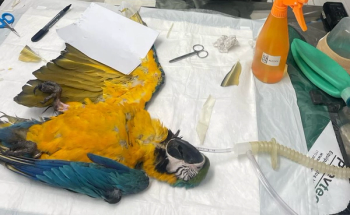
Veterinary associations outline strategies to respond to equine herpes virus outbreak
Veterinary associations, ACVIM and AAEP, have compiled resources to help veterinarians respond to an equine herpes virus outbreak.
National Report
— For veterinarians looking for guidance on the response and treatment associated with an equine herpes virus outbreak, the American College of Veterinary Internal Medicine and American Association of Equine Practitioners have published guidance on the disease, treatment and response to an equine herpes virus outbreak. AAEP has produced a detailed set of "Infectious Disease Control" guidelines.
The ACVIM statement, authored by multiple experts including Dr. David Paul Lunn, N. Davis Poynter, M.J.B.F. Flaminio, D.W. Horohov, K. Osterrieder, N. Pusterla and H.G.G. Townsend (JVetInternMed 2009; 23:450-461), contends there has been a perceived increase in the incidence of equine herpes myeloencaphalopathy (EHM) which is caused by equine herpes virus-1 (EHV-1). In fact, the virus can result in respiratory, neurological or abortigenic disease.
Horses can shed the virus from 10 to 14 days after infection. In some cases this period is even longer in horses afflicted with EHM, ACVIM reports.
Infection typically occurs in the respiratory epithelium. The virus has been described as producing weakness and ataxia, primarily of the hind limbs. Horses may exhibit urinary incontinence progressing to hind end paralysis and an inability to rise (classically known as the dog-sitting stance). Other signs can include nasal discharge and diminished tail tone.
According to Lunn et al., there are three priorities in managing an outbreak: early diagnosis, prevention of further spread and management of clinical cases.
Horses need to go in isolation, the report says. "Our ability to effectively prevent spread of infection from EHM cases when they are managed in the same building as other horses, even with extensive barrier precautions, are ineffective. Both aerosol and fomite transmission are important modes of transmission."
"Prognosis depends on severity of signs and the period of recumbency," AAEP adds in correspondence with its members.
Other important facts about this virus include:
• There is no specific treatment for EHV-1, although antiviral drugs (i.e. valacyclovire) may have some value before neurological signs occur.
• Non-specific treatment may include intravenous fluids, and other appropriate supportive therapy.
• The use of anti-inflammatory drugs (NSAIDs) is strongly recommended.
• Currently, there is no equine vaccine that has a label claim for protection against the neurological strain of the virus.
To read more of AAEP's resources
click here
.
To access ACVIM's Consensus Statement
click here
.
Newsletter
From exam room tips to practice management insights, get trusted veterinary news delivered straight to your inbox—subscribe to dvm360.






